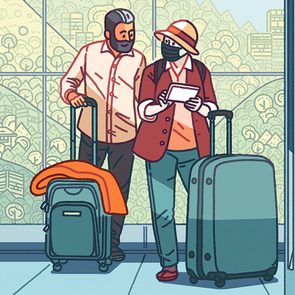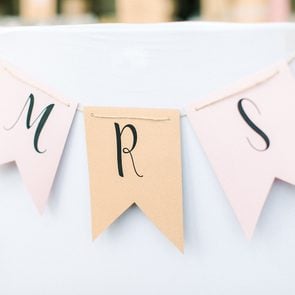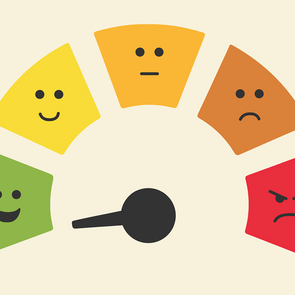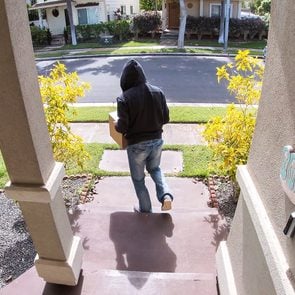Losing your luggage while flying is the worst. We’ve all been there: You arrive at your destination only to discover your bag is nowhere to be found. Of course, you really needed the stuff you packed, but beyond that, you start stressing that your things will never make their way back to you. Even though lost luggage is often completely out of your control, you might be surprised to learn that isn’t always the case. In fact, sometimes it’s actually your fault.
According to a viral TikTok video currently making the rounds, the issue lies with those little baggage stickers on your luggage. You know, the ones about the size of a postage stamp. Things can go very, very wrong if you forget to remove the old ones on your bags before your next flight. Here’s what you need to know about those stickers—and how to prevent this frustrating mishap.
Sign up for our Daily Digest newsletter for more travel tips, home hacks and humour, all week long.
What happens if you don’t remove those small baggage stickers?
@flyontairport Pro Tip: If you dont want your bags to get lost when traveling… remove old stickers from past trips off your luggage. #FlyONT #SoCalSoEasy ♬ Sunshine – WIRA
In a video recently shared to TikTok by Ontario International Airport in California, an airport worker explains it can be a huge problem when you don’t remove those baggage stickers. “Let’s say you flew American, and then a month later, you flew Southwest,” he says. “Well, there’s a little sticker that goes on for American that tells the computer that it should go there.”
Pointing to a newly affixed sticker, he continues, “So if your month-old American sticker is on there, there is a chance it scans instead of this one.” The result? Your bag doesn’t make it onto your flight—and instead ends up at the airline’s unclaimed baggage centre, before heading to the airport’s lost and found.
That old sticker also pertains to the airline you flew previously, which can complicate things further. To use the example in the video, if you’re now flying Southwest but your old sticker says American, your bag might end up in the American terminal, making it that much harder to track down your missing bag.
What information is on those baggage stickers, exactly?
A lot of very specific information that ensures your bag arrives with you at your destination. Baggage stickers contain barcodes that link the bag to the individual traveller and airline ticket, as well as details about your airline, flight and date of travel. While their original purpose is to provide a backup solution in case the main tag gets damaged or lost, the barcode on the sticker can be scanned to get details about your bag or reprint the main tag if necessary. These stickers get scanned first by the agent when you check your bag, then by baggage handlers throughout your journey, so they know where to direct it. Even if the first person scans the correct tag, the second one might scan a rogue sticker and mayhem could ensue.

Even seasoned travellers can make this mistake
This past summer, frequent flier Harvey Silikovitz became a member of the prestigious Travelers Century Club, an organization for travellers who have visited more than 100 countries and territories around the world. Despite a lifetime of travel, Silikovitz found himself in this exact situation when he returned home to New York after a trip to Chicago.
He checked his bag at Chicago’s O’Hare Airport before boarding his New York-bound flight, but neglected to take off the old stickers from his original flight to Chicago. The agent at the gate didn’t remove them either, and Silikovitz never thought to check. “Usually they will remove the stickers, but if you leave them on, you take the risk that they won’t,” he explains. “They scanned my old sticker, which had a destination of Chicago.”
Once he got to New York, he couldn’t find his bag … and even more concerning, the airline had no record of his bag ever being scanned. “I called up the airline and said, ‘What would happen if it went on to the conveyor belt with the original stickers on it, rather than the ones that should have been placed on the bag so that it could be loaded onto my outbound flight?’ And it was exactly what had happened. Unbeknownst to me, my bag ended up [back] at O’Hare!”
Luckily, Silikovitz wasn’t without his bag for long, but that might not have been the case if he hadn’t asked that question. “If I hadn’t had the presence of mind to call them and say ‘Could this have happened?’ who knows how much time would have gone by?” He also had his contact information on his bag, which helped the airline workers identify it quickly once he spoke to someone.
How can you prevent this from happening to you?
Fortunately, this is an easy problem to avoid. “Get into the habit of removing the sticker,” says Silikovitz. “Do it either when you get to where you’re staying at your destination or, even better, as soon as you retrieve your bag.”
Beyond that, here are a few additional steps you can take:
- When you check your bag, make sure the agent gives you a baggage claim sticker—and hang on to it. (Sometimes you’ll receive your baggage claim sticker with your printed boarding pass, but if you’re using a mobile boarding pass, the agent will simply hand it to you.)
- Make sure the agent puts the new sticker on your luggage.
- Use the airline app to track the status of your bag.
Next, check out our guide to flying budget airlines in Canada.
Walking through your neighbourhood this fall, you’ll notice a twist on the traditional Halloween hues of orange and black. The classic orange pumpkin has been joined by decorative varieties ranging in colour from pure white to grey, green, blue, yellow, red, and now, even pink.
Here’s what you need to know about those coveted pink pumpkins as well as other gorgeous heirloom varieties that are popping up on porches across the country.
Where do pink pumpkins come from?
While pink pumpkins may be relatively new to consumers in Canada, they’ve actually been around for longer than anyone can date, according to farmer David MacTavish of Burlington, Ontario’s Hutchinson Farm. A common variety of pink pumpkin is the Moranga, a Brazilian gourd that comes in a pale salmon hue.
As decor trends evolve, so does the demand for specific types of pumpkins. Most pumpkins are heirloom varieties that have been bred for decades or even centuries, occasionally with seed companies rebranding or renaming them as a marketing tactic. Occasionally, farmers may cultivate a new hybrid pumpkin such as the Mellow Yellow, an attractive, decor-friendly variety that was introduced in 2019. However, most of the pumpkins you see in Canada today have been grown in Central America for hundreds of years.
“Modern breeding tends to be dominated by orange pumpkins—high-yield pumpkins intended for carving,” MacTavish says. As for why pink pumpkins are suddenly so popular, the answer may be as simple as looking at Pinterest or Instagram. Once the style took off online in the form of social media posts and decorating inspiration boards, demand rose among consumers—in some cases, for a good cause. October is Breast Cancer Awareness Month—an effort that’s often symbolized with pink ribbons—and several nonprofits have started selling pink pumpkins in fundraising and awareness efforts.
Pumpkins are no longer just for Halloween
If you’re looking for some decorative accents to go with those traditional autumnal mums, dried corn husks or hay bales on your front porch, pumpkins are a great option throughout the fall season.
“Thanksgiving is now busier than Halloween in terms of pumpkin demand,” MacTavish explains. “It’s about getting different varieties for decorating versus people just wanting them to carve for Halloween.”
Mixing and matching is a popular decor style. “It’s really nice to decorate your home with contrasting colours and various sizes and shapes, so there’s no one specific cultivar that people are asking for,” MacTavish says. In previous years, all-white pumpkins were on trend and now, pink pumpkins are having their moment along with green and grey pumpkins that lend themselves well to a rustic, earth-toned look.
Are pink pumpkins edible?
Pink pumpkins make great home decor but at the end of the day, they’re still a vegetable in the squash family—so yes, go ahead and cook them up! In fact, according to MacTavish, if a pumpkin is anything other than orange, it’s probably worth a taste. “Orange pumpkins are the worst ones to eat because they’re bred for carving and size.”
That trendy pink Moranga pumpkin from Brazil has a great texture for roasting, and is just the right sweetness for soups and stews. The white Casper pumpkin, reddish-orange Cinderella pumpkin and Red Warty Thing (yes, that’s its name!) are also delicious in savoury dishes.
If you’re baking a pie, you might be tempted to get a Sugar pumpkin because of their popularity in classic fall desserts. These small, readily available gourds are often referred to as “pie pumpkins” due to their sweetness and creamy texture after cooking. While you can definitely go this route, MacTavish asserts that a Winter Luxury pumpkin is far superior in flavour. He also recommends Australian Blue and French Musquee De Provence pumpkins for pie making because of their sweet taste and delicate flesh. (Here are 10 fall pies you’ll want to bake all season long.)
When is a pumpkin ready to eat?
If your front steps are decorated with colourful heirloom pumpkins, keep an eye on the weather. After a few frosty nights, they’ll be ready to enjoy for dinner or dessert. “If you eat pumpkins too early there are a lot of starches, but as they mature, those starches turn into sugar,” MacTavish explains, noting that colder weather helps the process along. “If you wait for those frosty nights, you’ll get great taste.”
Decor you can turn into dinner? Sounds like a great plan to us!
Next, check out 10 tricks for the best Jack-o’-lanterns ever.
When it comes to fashion, there are few design elements more baffling than reaching into the pockets… only to find the pockets sewn shut. While this phenomenon occurs across all types of garments, you’ll discover that most new suits come with their pockets like this. As a result, it can be hard to know if the pockets are real or faux—so, you’re probably thinking, “What’s the point?”
Though it may seem strange, there’s actually a reason why suit pockets are sewn shut. But it’s up to you to decide if the answer is suit-able.
Were suit pockets always sewn shut?
In the 19th-century, suits were traditionally designed with a layer of horsehair canvas stitched to the inner wool fabric to help hold the shape of the suit. With proper care, these handmade custom suits could last for up to 30 years. It wasn’t long until suit manufacturers shifted to producing fused jackets held together with glue, which were cheaper to mass-produce and kept customers coming in for a brand-new suit since it wore out more quickly.
“Ready-made suits had to look like suits, but the makers didn’t want people to put things into the lower pockets,” says Rojer Baron, a tailor at Toronto-based Lee Baron Bespoke Custom Tailors. “If a customer put too much into the pockets, the whole jacket would lose its shape.” Heavy pockets meant that the fabric was more likely to stretch and wear out over time.
“The [suit manufacturers] discouraged the use of the jacket pockets, which is why they were only for show and not to be used,” says Baron. By sewing them shut, the original shape of the jacket could be preserved while keeping its aesthetic appeal.
Should you keep pockets sewn shut?
Although you may find contemporary suit pockets sewn shut, they can also be cut open. The sad truth is that not all of the pockets are functional. Some are purely for design purposes and if you remove the stitching, you might end up with a gaping hole in your jacket. An easy way to spot a real pocket is to look for a tacking stitch, which is usually a single, loose thread used to create a temporary seam.
If you hit the jackpot and find a real pocket, all you need is a seam ripper to open it up. As you gently tug along the thread line, the seam should easily unravel. But more pocket space comes at a cost. To maintain the shape of your suit, Baron recommends to only carry small, lightweight items and avoid overloading your pockets.
Whether you choose to open your suit pockets or keep them sewn shut, you now know the tips and tricks to do what suits you best.
Next, find out why maple syrup bottles have those tiny handles.
You made plans with friends for a night out … only to have a surprise work deadline come up. Or you booked a date weeks in advance … only to come down with a nasty cough the day before. Or perhaps you volunteered to chair the PTA fundraiser and now … well, you just don’t have the energy to deal with it. We’ve all been there, faced with the prospect of needing to back out but not sure how to cancel plans politely and kindly.
Why is it such a big deal to cancel? Plans are about priorities and how we choose to make use of our limited time and energy. “Oftentimes, having to cancel plans isn’t so much about etiquette as it is about time management,” says Jan Goss, founder of Show Up Well, an etiquette consulting agency. “Learning how to set boundaries, how to say no and how to value yourself will keep you from overextending yourself and will greatly reduce the number of times you end up in this situation.”
OK, so not getting in the position in the first place is ideal, but sometimes things just come up. That’s life! But backing out of plans at the last minute can leave you feeling guilty and your friends and family members more than a little irritated. We talked to etiquette experts to find out just how late you can cancel plans (without annoying everyone)—and how to do it the right way.
Sign up for our Daily Digest newsletter for more etiquette tips, home hacks and humour, all week long.
How to know if you should cancel your plans
“Once a commitment is made, unless you have a legitimate excuse, it’s rude to cancel. Period,” says etiquette expert Lisa Grotts, founder of the Golden Rules Gal. So what, exactly, is a legitimate excuse?
“Without question, death, travel delays, severe illness and other things out of your control are understandable,” Grotts says. “But changing your mind because you ‘had a long day’ or are ‘too tired’ or because you got a better offer are not good reasons.” You run the risk of not just hurting the other person’s feelings but also making yourself look flaky and untrustworthy.
Of course, there are excuses that fall in a grey area, like a work project that is taking longer than anticipated, a mild (noncontagious) health issue or not finding childcare in time. In those instances, should you find a way to make it work? “These decisions often come down to integrity, because ultimately it’s about whether you are a person who keeps their word,” Goss says. “If you are normally someone who follows through, then people will understand and forgive the occasional cancellation. But if this is something that happens often, then it doesn’t matter how ‘legitimate’ your excuse is—people will see you negatively.”
Not to mention that if you cancel one too many times, you may find yourself off future guest lists and with far fewer friends, Grotts adds.
How late is too late to cancel plans?
In most cases, if you’re cancelling within hours or (yikes!) minutes of an event, it’s too late. And for more formal events, it’s essential to send your regrets much earlier. “The short answer will always be do it ‘as soon as possible,'” Goss says. “It’s human nature to want to put off having a difficult conversation, but the longer you wait to let the other person know, the more rude it becomes and the more inconvenienced and upset they will be.”
When deciding when and how to back out, follow the golden rule: Put yourself in the other person’s shoes and consider how your cancellation will affect them, adds etiquette expert Kelly Browne, author of 101 Ways to Create Mindful Forgiveness. cancelling plans in every situation.

When you’re sick
Getting sick is one of the most commonly used excuses for cancelling plans, and it can be a very legitimate one—a lesson we learned all too well during the pandemic, Browne says. In this case, it’s never too late to cancel. “If you are ill and know that what you have is contagious, or just think it might be, it’s always better to err on the safe side and stay home, even if it is last minute,” she says. Nobody wants their wedding ruined by COVID or explosive diarrhea!
How late is too late: Never
When it’s an event that required an RSVP and you already said “yes”
Events that require RSVPs, like weddings, baby showers and galas, require responses for a reason: Each person costs the host money, and they need to know how many guests to plan for, Goss says. Your no-show isn’t just inconvenient or sad—it’s expensive. Good wedding etiquette says that barring a serious unforeseen problem, you should give the host at least two weeks’ notice if you need to change your RSVP. Why two weeks? That’s generally the cutoff to give the final head count to caterers, Goss explains.
Cancel no later than: Two weeks before the event
Brush up on the latest wedding gift etiquette.
When it’s an event that requires a ticket
Movies, theatre productions and some parties require tickets to be purchased in advance, meaning that whomever invited you has already invested in your attendance. The earlier you let them know you can’t make it, the more likely they will be able to get a refund or find someone else to take your place, Browne says. If you do end up cancelling at the last minute, it is common courtesy to offer to pay for your tickets anyhow, she says.
Cancel no later than: One week before the event

When it’s a work function
You may love getting together for work events, or you may dread them. But either way, if they are part of your job or company culture, you need to make a good-faith effort to attend, Grotts says. Some people see “fun” work events, like holiday parties, as more work … especially since they’re usually unpaid. But the reality is that this is how working relationships are strengthened. So if you do need to cancel, make an extra effort to connect with your co-workers in a different setting, or find a way to compromise—say, by coming for part of the time or helping with the prep work.
Cancel no later than: One week before the event
When it’s a place that requires reservations
Similarly, if your plans involve going to an upscale restaurant, a museum, a wine tasting, a tour or another event that requires reservations in advance, you should give extra notice. This allows the person who invited you to cancel the reservation or find someone else to fill your spot. Again, if you have to cancel at the last minute and they were unable to fill your spot, you should offer to reimburse them for the cost they are out (if there is any), Browne says.
Cancel no later than: Three days before the event
When it’s a life celebration
Birthday parties, baby showers, graduation parties, divorce celebrations, job-promotion parties, milestone-anniversary parties—celebrating your loved ones’ big life events is one of the best parts of having loved ones! These sometimes don’t require RSVPs or reservations, but the meaningfulness of the event should give it extra importance in your schedule. “This is one time when you can really show up for your loved one (literally), helping them feel extra loved and supported on their special day,” Goss says. Plus, she adds, if you simply don’t show up, they may end up waiting for your arrival to start the party … until it becomes clear that you’re just not coming.
This may be a good event to try to compromise on attending. “You could come for part of it, or ask someone to FaceTime or Zoom you in for the important parts,” Browne says. And, adds Goss, if you committed to bringing something—like a gift or food—do your best to make sure it still gets there on time. “You can have flowers delivered or Doordash the appetizers,” she suggests.
Cancel no later than: 48 hours before the event

When it’s a casual get-together
“Want to grab drinks on Friday?” Or: “I’m having a game night this weekend. Want to come?” Casual get-togethers can be fun and are a great way to bond with friends, family or co-workers, but because of their casual nature, they’re the events most frequently bailed on. “Your absence may not cost them a lot money-wise,” Goss says, “but it can take a real toll on your relationship, especially if it happens often.” And aside from the rudeness factor, it’s just annoying.
“Good friends always understand a last-minute change of plans and the need to reschedule—we all have busy lives,” Browne says. “However, if you constantly cancel plans, you either need to rethink that relationship or your priorities.”
Cancel no later than: 24 hours before the get-together
When it’s a first date
You’ve matched with someone on Hinge or you’ve been set up on a date—but you end up not being able to make it. Ghosting is all too common in these situations, and even though the person is basically a stranger, you still owe them the common courtesy of cancelling. Is there anything more painful than showing up for a date, waiting for an hour (or more) and then realizing the other person isn’t coming? (The one exception, Goss says, is if the person has made you feel unsafe.)
That said, you can cancel a date for any reason; it doesn’t even have to be a “legitimate” one. “Never feel like you need to go out with someone out of obligation,” Browne says. “You are wasting their time as well as your own.”
If you don’t want to go out with them after all, cancel politely but firmly. If you’re using an app, communicate the cancellation through the app—don’t give out your personal contact information, Goss says. On the other hand, if the reason for your cancellation is something unavoidable and you still want to see them, offer to reschedule.
Cancel no later than: 12 hours before the date
When it’s a repeat date
You’ve started seeing someone, and even though things aren’t serious yet, you’d like to see them again. In this case, cancelling plans should be done with more care, Goss says. This is because cancelling for any reason—even a totally legit one—can feel like rejection. You don’t owe anyone a full explanation for cancelling plans, but this might be one case where you could offer a little more detail so they know you’re not trying to back out of the relationship.
“One of the cardinal rules of relationships is that if someone wants to spend time with you, they will find a way to do that,” Browne says. “So if you value the relationship, cancel and then make a plan to reschedule.”
Cancel no later than: Six hours before the date

When it’s a date with a long-term partner or spouse
Unfortunately, people tend to be more likely to cancel plans at the last minute with their spouse because “family understands.” They know that person will forgive them—as opposed to their demanding boss or needy friend. “Don’t do this!” Goss says. “These intimate relationships deserve even more care and consideration when cancelling plans, not less.”
Browne adds: “As an important relationship in your life, cancel plans only if absolutely necessary. You want to assure that person that you value and treasure your time together, so explain your reason for cancelling and immediately reschedule your date.”
Cancel no later than: Two hours before the date
When you’re the host
Sometimes the person hosting the event is the one who gets sick or has a personal conflict that requires calling off the whole thing. This is a much bigger deal than one person backing out of plans, but chances are you wouldn’t be doing it if it wasn’t an important reason. “Just be considerate of how your guests will be impacted by the cancellation, especially in regard to travel, costs, time and childcare,” Goss says. And know this: A great host will cancel as soon as possible.
“This is a situation where technology is your friend,” Browne says. “You want to get the information out quickly, so send an email or text saying something like: ‘Unfortunately, due to circumstances beyond our control, we must cancel our party. We look forward to celebrating with all of you at a future date.'”
Cancel no later than: One week before the event
When it’s a true emergency
There are some reasons for cancelling that are so catastrophic—think: a death, serious accident, medical crisis, natural disaster, or extended flight cancellation—that your primary focus should be on caring for yourself and your loved ones. If you have time (like if you’re stuck at an airport for hours), it’s a courtesy to let the other person know that you need to cancel, and you should do this as soon as possible. But generally, people will understand if you aren’t able to give them advance notice, Grotts says.
How late is too late: Never

How to cancel plans without being rude
Once you’ve decided you need to cancel plans, your focus should be on doing it in the kindest, most helpful way possible. “The culture these days has gotten more relaxed about proper cancellations, but this isn’t about protocol—it’s about compassion,” Goss says. “This is about responsibility, integrity and respect for the other person and how your backing out will impact them. It’s likely they will be, at the very least, disappointed, but they may also be greatly inconvenienced or out money. You need to acknowledge that.”
Here’s how to cancel plans while still being polite and kind.
Don’t say “yes” when you mean “no”
The best way to cancel politely is to avoid having to cancel in the first place. Too many people make plans with someone or agree to attend an event that they really don’t want to follow through with—leading to last-minute cancellations. Instead, learn how to politely decline an invitation so that the only invitations you are accepting are ones that you prioritize, Browne says.
Cancel in person or over the phone
“Face-to-face is best, but voice is second when cancelling plans, because it adds a personal touch,” Goss says. Texts and emails are OK too, especially when responding to digital invitations, and that’s certainly better than simply not showing up. But again, you should cancel in person or via phone whenever possible.
Don’t lie or exaggerate
You shouldn’t lie about your reason for cancelling plans, and don’t use “I’m sick” as a “get out of things you don’t want to do” card. “The more often you use these made-up excuses, the less credible they become,” Goss says. The truth has a way of coming out, especially if you show up somewhere or post on social media the next day, appearing to be perfectly fine.
Apologize
A solid apology should be the heart of any cancellation. You don’t have to accept blame, wallow in it or insult yourself—life happens, and you’re allowed to cancel plans. Just offer a sincere “I’m so sorry,” and then move on. “Apologize, make amends if necessary and then let it go,” says Goss. “You don’t need to keep feeling bad about it.”
Don’t offer detailed excuses
It’s tempting to give the other person a full explanation of your violent stomach bug so they know how serious you are about cancelling, but restrain yourself. “It’s not necessary to share personal details,” Browne says. “Simply say something like, ‘My apologies, I am not feeling well,’ or ‘I’m so sorry I won’t be able to make it tomorrow.'” In fact, over-explaining is one of the telltale signs someone is lying.
Thank them for the invitation
Be sure to acknowledge the person’s kindness and thoughtfulness in extending the invitation in the first place, Browne says. This can also be a good time to offer a compliment or well wishes. Depending on the event you’ll be missing, try something like, “Thank you so much for thinking of me. I know it will be a magical night, and I can’t wait to see pictures!”
Don’t waffle
“If you are cancelling, be crystal clear about it,” Goss says. This means not saying things like: “I probably can’t make it, but I’ll try,” “I hope I can still make it, but it’s not looking good” or “If I can find childcare, then I’ll come.” These kinds of answers may feel like you are sparing their feelings, but they are actually incredibly unhelpful, because it makes it difficult for them to plan around you. It also makes you look flaky, Goss adds. If you’re unsure, then your answer should be no.
Offer to make it right
As noted above, in some situations, the other person isn’t just disappointed by your cancellation—they’re inconvenienced by it as well. So if the other person will be out money for tickets, offer to pay for yours anyway. If you promised to bring something, deliver it ahead of time. If it’s a gift-giving occasion, send the gift regardless of your attendance. If it’s a big life event, offer to meet up with them afterward so they can show you pictures or tell you about it.
Reschedule
If this is a relationship you want to preserve, then offer to reschedule—and don’t just say, “Let’s do it another time!” It should be a sincere, detailed offer, Browne says. Here’s a mini script of what to say to get you on the right track: “I’m so sorry I can’t make it tonight, but I’d love to spend time with you. What does your schedule look like next week? I could do lunch Wednesday or Thursday.”
Next, check out the email etiquette rules everyone should follow.
Imagine that it’s a cozy Friday night at home, and you’re all settled in to binge-watch your favourite show. You’ve got your snacks lined up, your comfiest blanket at the ready and the perfect spot on the couch. There’s just one problem: Your Wi-Fi signal is dragging.
In this age of instant streaming and virtual meetings, all of us are sadly way too familiar with that dreaded spinning wheel. But what if I told you there’s a tech tip that promises to put an end to your Wi-Fi woes, and the solution is a household staple that’s probably sitting in your kitchen right now?
Yes, you read that right. Turns out, boosting your Wi-Fi signal is one of many fascinating aluminum foil uses you never knew about. To get the inside scoop, I asked an expert to explain how this trick works and even grabbed my lab coat (aka my pajamas) to test it out. Thanks to a strategically placed sheet of aluminum foil, you just may be one step closer to banishing sluggish internet connections for good.
Sign up for our Daily Digest newsletter for more tech tips, home hacks and humour, all week long.

How can aluminum foil boost a Wi-Fi signal?
The way this hack works is shockingly simple. But first, you need a little background on Wi-Fi signals: They come from the antenna on your router, which creates the connection with your smartphone, computer and other internet-connected electronics. To reach all the devices in your home, these signals behave like radio or light waves, spreading out to cover every available space—”like a sprinkler head spraying water in all directions,” according to tech expert James McQuiggan, a security awareness advocate at the online security platform KnowBe4.
Unfortunately, this can make the signals less efficient, weaken the connection and reduce the speed of your internet. Not only does it send Wi-Fi signals to parts of your home where you don’t need it, but it can also lead to dead zones in certain areas where the signals can’t reach or are blocked by large obstructions like walls or floors.
By placing a curved sheet of aluminum foil around the router, you can shape the flow of the Wi-Fi signals more effectively. The shiny side of aluminum foil will reflect the beams coming from the antenna and point them at a specific place. From there, all you have to do is adjust the direction of the foil’s curve to steer the signal toward the parts of your home where you need better internet connection (like your living room, bedroom or office) or direct it away from spots where it would be wasted, like a window.
Does this actually work?
If you think this trick sounds too good to be true, we don’t blame you. But don’t just take our word for it—researchers at Dartmouth University vouch for it. When they tried it out for themselves, they found that using a reflective, curved surface like a soda can or a piece of aluminum foil could strengthen Wi-Fi signals in some spaces and weaken it in others, maximizing the coverage’s overall efficiency.
Still skeptical? In their paper, the researchers reported that their 3D-printed shape covered in aluminum foil, which they designed to match the specific Wi-Fi needs of the room, was able to boost wireless signals by up to 55.1% in certain spots, as well as reduce them by up to 63.3% in spots where Wi-Fi wasn’t needed. So there you have it!
Are there any other benefits to using aluminum foil with your router?
Strengthening your Wi-Fi speed isn’t the only perk of this handy hack—it can also boost your online security, according to the Dartmouth researchers. By limiting the reach of your Wi-Fi’s beams to the areas where you actually use it, you can reduce the risk that hackers will access the signal and attempt to steal your data. “Such physical confinement of wireless signals serves as a complementary method to existing network security measures, such as encryption, and hence raises the barrier for attackers,” the researchers wrote.
Find out the password mistakes hackers hope you’ll make.
How to use aluminum foil to boost your Wi-Fi signal
Step 1: Gather your materials
Find a roll of aluminum foil, and cut a sheet to be approximately a foot long and the height of your Wi-Fi router. If your router has a physical antenna extending from the top, make sure the foil reaches a few inches above it. This won’t matter for routers that have an internal antenna.
Step 2: Fold the foil
Bend the foil to create a “C” shape, with the shiny side of the foil facing inside the curve. For routers with outer antennas, you might need to fold the top so that it covers the antennas too.
Step 3: Position the foil behind your router
Place the foil behind the router, with the curved portion facing toward the router and the target area where you want to boost the signal. You might need to fold the bottom part so that the aluminum foil can stand upright.
Step 4: Check your internet speed
Go to the targeted area, enter “Google speed test” into your phone or computer browser’s search bar and select the blue button that reads “run speed test.” The test will evaluate both the upload and download speeds of your internet connection and deliver a brief report.
Can you use other household staples for this purpose?
While aluminum foil is a lightweight, flexible and widely available option, it’s not the only item that can improve your Wi-Fi. Other common household metals—such as steel or copper baking sheets, or soda and beer cans—could be equally effective for this hack, McQuiggan says. Just make sure to position them so that the curved, reflective part faces toward the area in your home where you want to amplify the Wi-Fi.
Here’s what happened when I tried this Wi-Fi hack at home
I decided to put this aluminum-foil hack to the test from my porch, which is one spot in my home that always has a poor internet connection. Before I started, I compared the internet speeds between my porch and living room, where the router is located. The difference was massive: I got a download speed of only 30 Mbps from my porch versus 230 Mbps from my living room.
Now it was time to add the foil. After cutting a single sheet of aluminum foil, I folded it into a “C” shape, with the shiny side facing inward, and placed it beside my router, making sure the concave part faced toward my porch. When I went outside and ran the speed test again, the download speeds had slightly improved, bumping up to 35 Mbps. Meanwhile, the download speeds in my living room had dropped a little to 225 Mbps. I beefed up the test by adding two sheets of foil instead of just one, as well as replacing the foil with a soda can, but no dice. In fact, the two additional tests seemed to make my Wi-Fi speeds worse. Trying to load a Netflix show, for example, took a little bit longer than before.
Next, I tried this trick from my bedroom. Without the foil, download speeds in this room ran anywhere between 226 and 229 Mbps. One sheet of aluminum foil didn’t make any difference at all, and using two sheets of foil or the soda can seemed to drop speeds by a few Mbps. I tried adjusting the angle that the curved portion of the foil or can faced, as well as their locations beside the router, but I didn’t notice much of a difference with my internet speed when I tried to connect.
The verdict: Though it didn’t quite work for me, it can’t hurt to give this trick a shot before forking over significant cash for a Wi-Fi extender if you’re having internet connection problems. After all, it did work for the Dartmouth researchers. I would venture to guess that this hack might be more effective at improving your internet speeds depending on the size of your space, the number and type of obstructions between your router and device, and your internet plan.
Other options for boosting your Wi-Fi
Even if you strike out with this hack, fear not. McQuiggan notes that there are plenty of other fixes for sluggish Wi-Fi. “While foil can help concentrate the signals, it’s usually not a great solution compared with upgrading your router or positioning it more optimally,” he says. He recommends placing your router in a central, elevated location in your home without obstructions. You can also try other solutions, such as rebooting your router, to improve your connection when you’re having an issue.
Next, check out 10 iPhone hacks you’ll want to try right away.

The Funny Things Kids Say
My two young children were watching me assemble a swing set. Tightening the screws was difficult for me, so I asked their father to come and help. He swaggered out, grinning like the hero, and tightened the screws. My three-year-old blurted out, “Mommy makes things and Daddy screws them up.” —Dale Jewett, Wasaga Beach, Ont.
Me: “Where are your dirty clothes?”
My 10-year-old: “On the floor.”
Me: “Where should they be?”
My 10-year-old: “On the floor where you can’t see them.” —@XPlodingUnicorn
I told my daughter to put socks on her baby doll. She responded, “You can’t tell people how to take care of their kids.” —@nyooxo
My kid just told me he needs to take 120 of “something” to school tomorrow, so his choices are Cheerios or my tears. —@deloisivete
My three-year-old son was crying in the car while we were driving. I noticed a police car driving near our car, so I said he shouldn’t cry in front of the police. He quickly stopped. Shortly after, the police car drove ahead and away. My son said, “The police are gone. Can I cry now?” —Ruchi Prasad, Ottawa
When my daughter started elementary school, she made some new friends and they started to go to each other’s houses after school. Every time I picked my daughter up from one of their homes, the mother would make a point of saying what a great job I was doing with her. It was nice of them to say, I thought, but a little over the top. I was just doing what mothers do, wasn’t I?
Eventually I pointed this out to one of them. She patted me on the arm and said, “Yes, you’re doing exactly what her real mother would have wanted you to do.” I soon learned my highly imaginative daughter had told all her friends that her family had been in a shipwreck, her parents had drowned, and I had rescued her and agreed to adopt her.
I had to set the record straight, but I must admit, I miss being treated like a hero in the school playground. —Kay Stead, York, United Kingdom
My six-year-old daughter, to her crying brother: “It’s okay to be sad. Sometimes we need to let our feelings out.”
Me: “Oh darling, that’s so lovely. Well done. Why is he crying?”
My daughter: “I hit him.” —@elspells13
My grown son asked my nine-year-old grandson, “What did you learn at school today?” He responded, “Apparently not enough because I have to go back tomorrow.” —Janie Teasdale, Antigonish, N.S.
Looking for more laughs? Add these funny podcasts to your playlist!

I told my 5-year-old that he could have some popcorn if he promised to listen to me more. His response was, “What did you say?” So we’re off to a great start. —@Kevinthedad
My son calls the butter shelf in the fridge “the dairy penthouse.” —@Itssherifield
I was writing in my journal at the kitchen table while my grandson, age 10, sat beside me eating his cereal. Eli watched my cursive carefully for several minutes, then said, “You should learn how to print. Nobody’s ever going to be able to read that.” —Brenda Nicholson, Rocky Mountain House, Alta.
Last winter, during a period of unpredictable and reduced snowfall, a nearby ski resort got snow-making machines. When I told a 10-year-old I know that the machines could generate enough snow to cover 10 football fields, the kid quickly interjected, “Why don’t they use the snow to cover the ski slopes instead?” —Deepak Vohra, White Rock, B.C.
My husband and I have a 3-year-old who believes the whole world revolves around her. One night, when her dad was out socializing, she asked me what he was doing. I told her he was having fun with his friends. She replied in a shocked voice, “He can’t be having fun there when I’m here!” —Shawna Mathieson, Watson, Sask.
My kid asked me what gaslighting is, but I didn’t know how to explain it so I just said it’s not a real thing. —@Ihidefrommykids
My daughter was lecturing the cat about eating too much and I’m nervous that I’m next. —@Katiedeal99
My husband showed our 5-year-old son a picture of himself at the age of 16 and asked Harri if he knew who it was. He stared at it for a long time before replying, “It’s me when I’m bigger!” —Shulah Clarkson, Great Yarmouth, U.K.
4-year-old: Mom, the whistle makes my brain hurt.
Me: Mine, too.
4-year-old: *blows whistle again* —@Deloisivete
After picking up our 4-year-old granddaughter from school, I was trying to get her changed out of her uniform into something casual when my husband started teasing her. All her squirming and screaming with delight wasn’t helpful for the task at hand, so I asked my husband, “Why don’t you go and make us some tea?” When he left, our granddaughter Claudia looked at me and said, “That should keep him busy.” —Rose Demmer, Oakville, Ont.
While getting my two kids ready for a long road trip, I asked them to please not ask “How much longer until we get there?” I said we would be travelling all day and wouldn’t arrive at our destination until dark. An hour into our journey my 6-year-old piped up, “How much longer until it’s dark?” —Heather Trundle, 100 Mile House, B.C.
Here are 25 knock-knock jokes that are genuinely funny!

My three-year-old as she pulls out a chess board from a storage box: “I haven’t played this in years!” —Reddit.com
My son is arguing with my husband about a math problem. My husband is an engineer. My son is in Grade 4. His confidence is strong. —@Bunandleggings
I overheard my 11-year-old daughter record her voice mail greeting: “Hi, you’ve reached my voicemail. When you hear the beep, hang up and send me a text.” This generation gets it. —@Dad_at_law
One day my nine-year-old son came home from school and joyfully told me, “My friend said that if we press the airplane mode button on a cellphone, it might be able to fly away like an airplane!” —Janis Chen-Yi Ko, New Westminster, B.C.
A woman in the bathroom stall next to me was struggling to convince her toddler to use the facilities. “You need to go,” I heard her plead. “It’s been two days!” The toddler responded, “But my poop wants to stay home.” —Rita Hickey, Brampton, Ont.
We went to a nice hotel for lunch the other day. Afterward, we stopped at the valet booth to ask them to retrieve our car. My toddler asked the attendant inside, “Is this your house?” —Reddit.com
My four-year-old daughter was sitting in an adjacent room and sneezed. After a brief pause, a little voice came from the room: “Isn’t anyone going to ‘bless you’ me?” —Stacey Thompson, Oshawa, Ont.
When we’re in the car, my daughter and I have a game where she plays a song and I guess the artist and title within seconds of listening. She’s unaware the song information is on the dashboard. —@Djlevela
My granddaughter was looking at old photos of her father, taken before our family immigrated to Canada. “Thank you for bringing my dad,” she told me. “Otherwise, me and my sister would be here alone with our mom!” —Mirjana Kovacevic, Toronto
My son just turned three, so I took him for his yearly checkup. The doctor asked him what his favourite fruit was, and he said cheese. —@Dadof2crazyboys
I was making my toddler a peanut butter and jam sandwich. She examined the containers and I asked her which one would be more dangerous if it fell on the tile floor. She said, “The glass one because then we’d have no more jam!” —Ashley Ashfield, Hampton, N.B.
When we passed a wind turbine farm, my son asked me if they make the fans go faster when it gets hot. —Richard Merrick, Orangeville, Ont.
These hilarious birthday jokes are sure to make you smile!

My toddler asked what my favourite animal is, and if I’d known she was going to spend three hours calling me the name of this animal I would not have said manatee. —@Lottie_Poppie
I gently woke up my four-year-old to get ready for daycare. He sadly said, “You broke my dream,” rolled over and pulled the covers over his head. —Reddit.com
In case you’ve ever doubted the brilliance of a toddler, mine just told me that a kid in her daycare is allergic to peanut butter so I have to send her chocolate instead. —@Reallifemommy3
After I dumped a load of warm towels out to be folded my three-year-old curled up in the towels and said, “I just want to be laundry.” —Reddit.com
Me: What are you looking forward to doing as a grown-up?
My four-year-old: I’m not doing that. —@Lifepitts
My wife was trying to tell our five-year-old a story and two minutes in, he interrupts to say, “Who are you even talking to?” —@KevinTheDad
My 13-year-old had to draw a woman he admires for an art project and when he told me he chose me, my heart almost exploded. But then he said, “My sister is too little so you were the only other choice.” —@SnarkyMommy78
My daughter said she can’t wait to have kids. I asked her why and she said, “So they can bring me stuff when it’s in another room.” —@HollyBallantine
Me: Different people believe in different things.
My daughter: Like how some people believe in unicorns and some believe in turtles. —@KatieDeal99
My four-year-old learned all about wrinkles today after she asked me where I got my forehead stripes. —Reddit.com
“Why does he have stickers on his teeth?” My three-year-old daughter when she saw a picture of her cousin after he got braces. —Reddit.com
“I don’t need pants. I can pretend my legs are pants.” My five-year-old getting dressed after bath time. —Reddit.com
My five-year-old: Why are we named after a vegetable?
Me: What do you mean?
My five-year-old: Human Beans. —Reddit.com
My three-year-old asked if they had batteries inside them. When I told them no, they asked, “Then how come I can talk?” —Reddit.com
My four-year-old will not fall asleep. She said it’s because she wonders what she looks like when she’s sleeping and it’s keeping her awake. —@AOTAKEO
My five-year-old made us breakfast in bed yesterday. He brought orange juice and cereal, and when I asked where the toast and eggs were, he replied: “Make it yourself, this isn’t Hogwarts.” —@GrahamKritzer
I asked my five-year-old to share her grapes with her brother and she said, “I haven’t figured that out how to do that yet,” and carried on eating the grapes. —@MumInBits
An elderly relative looked at my six-month-old and exclaimed, “I bet you just get all the attention, don’t you?” My five-year-old said, “She can’t get all the attention, she doesn’t even have any teeth!” —Reddit.com
Next, check out these funny parenting quotes every mom and dad will relate to.

My interest in cars started around 1975 when I was about 12 years old. There was a guy on our block who had two 1965 Mustang coupes. One had a primer paint job in poppy red that was more orange than red, and the other was black. The orange one was missing front fenders and the other front end pieces, but that’s the one that caught my eye. What I eventually learned is that he found the car damaged at the Hilltop Machine Shop in Nipawin, Saskatchewan, and bought it to blend both cars to make one good car. That’s exactly what he did and the orange/primer car was reborn.
Eventually he took me for a ride in it. I was instantly hooked! Around 1977, my dad bought it for me when I was 14. It sat in my yard until I had my learners’ license. I worked at his service station for money to buy license plates, put insurance on it and gas in it.
I was known to drive the car quite aggressively, especially when practising my gear-shifting! That’s when my love of mechanics really began to kick in. You name it, I blew it up on that car—engines, clutches, transmissions, differentials—but I either repaired or replaced it all myself. I owned it about 15 years, and I’m sure my friends have stories to tell that I don’t even remember (and may not want to). I eventually had it painted all one colour—a bright poppy red.
Around 1991 the economy was very bad. By then I had married, we had bought a house and had a little one. With some pressure, and not without resistance, I sold the Mustang. Sometime later when my son was about 15 years old, doesn’t he say to me that he would like an old vehicle to fix up. I said, what about the old Mustang I had, if we can find it? He said sure and so the quest began.
The Search Begins
I still had the car’s serial number, but you have to remember, there were now privacy laws in place and that limited the resources you could use to help locate people and their vehicles. For the longest time, I could not remember the person I had sold it to, although I remembered the town. About a month went by and then an old customer of mine dropped by at work. I instantly remembered that his son was best friends with the person I had sold my Mustang to; he gave me the name and number of the new owner—the first in what turned out to be a long list.
New Owner #1
I called the first new owner’s house only to find out he had moved away and was unreachable, but his mom was still there and she found out that he had traded the car for a boat to a guy on Cold Lake Air Force Base. Then the mom really came through by finding out the guy’s name and phone number!
New Owner #2
I called the second new owner and he told me that he had the Mustang on a used car lot in Edmonton for six months. Then, he sold it to his wife’s brother-in-law on Vancouver Island. He only had the name for me, so onto Google I went, looking for the third owner under that name. I was about 40 phone calls into the process when I hit pay dirt.
New Owner #3
The third owner had the car in his possession for five years or so, then sold it to someone in Stony Plain, Alberta. That’s all the info he had for me.
Well, I had a friend I went to trade school with who lived in Stony Plain. I called him and he told me he wasn’t really into cars, but gave me the name of a local business that was. I gave the place a call and the guy who answered knew instantly what car I was talking about. He gave me the number of a repair shop, the last place as far as he knew that the Mustang had been sent to. The kid who answered my call there said, yes, he knew the guy who owned the car now and would call me back shortly.
New Owner #4
About half an hour went by and then a lady called, saying the Mustang was her dad’s, but he had recently passed away. The family had put the car up for sale and, after interviewing would-be buyers looking for someone who would really care for the car like her dad had, they settled on a guy in Calgary who had taken ownership about two weeks previously. So close and yet so far! Anyway, she put me in touch with him.
New Owner #5
It so happened I had to go to Calgary anyway and so I took the opportunity to go see the car. It was my old Mustang all right! I verified that, when I spotted some repairs I had done a long time ago, including a pretty unique modification to the throttle linkage, plus it had the same valve covers traction bars, and so on. No need to check the serial number—it was all my handiwork. And he wanted to sell it…but for way too much money. After all my searching, I left the car there and went home empty-handed.
The Consolation Prize
Meanwhile back at the ranch, my son was still itching to get his hands on a vehicle to work on. He opted for an old classic truck and we rebuilt and repaired it together. Two years flew by and then I heard about an international Mustang show taking place in Edmonton. Curious, I called up New Owner #5 to see if he if was taking his Mustang to the show. He said no, because he had sold it at a local auction.
Well, the chase was on again! I looked up the phone number for the auction place that the car had been taken to. They couldn’t tell me who had bought the car, but they agreed to forward my contact info to him.
New Owner #6
A couple of days went by and Owner #6 called me up: the car was now in Cranbrook, B.C. I was going on holidays close to there in a few months time and made arrangements with him to drop by, just to see it, along with my son. Well, what a joy—he even let me take my son out for a drive in it. He had just bought it and obviously loved it so much that I didn’t even bother to make an offer, just thanked him for the experience of driving it again.

Original Happy Owner
I never lost my affection for that ’65 Mustang coupe and kept scanning car sites for a similar one. No such luck, until ten years ago, when New Owner #6 listed my original Mustang for sale. I called him up and a price was agreed on. The money was arranged and then I was off to Cranbrook. When I arrived with a car trailer in tow, he started the Mustang to warm it up. The door was open and while he was keeping it running I reached in and felt around for a switch I had installed under the dash as a teenager. I clicked it a couple times and was asked by Owner #6 what it was for. “Mood lighting,” I said as a familiar red glow came on. He had owned the car for ten years and didn’t know the switch was there!
We loaded the car on to the trailer and I stayed the night at a nearby motel. The next day as I was driving through the mountains, I made a stop to check on the Mustang and realized that I had lost the car keys. I called the motel and they found them, and said they would mail them to my home address. Good enough, as I already had an idea how I might unlock the coupe and get it going.
When I got home, I went right to my jewelry box where I keep my valuables, looked inside and lo and behold there was the original key. It was so worn out I had replaced it decades ago, but kept the original. Out I went and, sure enough, the key did the trick! I off-loaded the coupe and took it for a run on my home turf—what a feeling! Sadly it snowed the next day and I don’t drive that car in winter weather, never did and never will. But come summer, I’m out cruising, going to shows and still just plain enjoying it!
Next, read the incredible story of how one man missed out on his dream car as a teenager, then found it parked in his driveway 25 years later!
Cookie-consent pop-ups are one of the biggest annoyances on the Internet. Almost every site you visit has a notice saying, “This website uses cookies to improve your experience. Do you agree?” or something similar. Typically, we click “yes” or “agree” without even thinking about it because we’re eager to get to the content. But should we? Not necessarily.
What are cookies, exactly?
Before we delve into the dos and don’ts of cookie consent, here’s a little refresher on this Web tool: Cookies are essentially information collectors and trackers in the form of small text files stored on your browser by the sites you visit. Some are useful. For example, a cookie saved on your browser makes it so you don’t have to re-enter your log-in information every time you visit one of your favourite websites. Cookies can also remember your shopping preferences so that you get a personalized experience when you visit the website. Others, however, track how you use a website, how often you go there, your IP address, your phone number, what types of things you look at and buy, and other information you may not want to share.
Do you have to accept cookies?
Many companies have you click “yes” so that they’re compliant with current privacy laws. This means that once you click, you’ve given the company permission to use your information as they see fit without the worry of legal backlash. Most of the time, cookies are no big deal. There are a few occasions, though, where you should decline cookies. Don’t worry—if you find yourself in a situation where you need to decline or simply want to decline for whatever reason, most websites will work just fine without collecting your information. With that said, here’s when saying no to the cookies is a good idea.

Sketchy sites
Beware when you’re on an unencrypted website (these websites will have an unlocked lock icon by the web address) while using a public Wi-Fi network. The information collected by cookies can be intercepted by hackers because there isn’t any security to stop them. Your best bet when borrowing Wi-Fi from your local coffee shop or fast-food joint is to use your browser’s private or incognito mode. While in this mode, cookies aren’t collected by default (though you can manually turn off cookie blocking on some browsers), no matter where your Internet journeys take you. Something else you’ll definitely want to know: the password mistakes hackers hope you’ll make.
Third-party cookies
If the cookie-consent pop-up mentions third-party cookies, click “decline.” Accepting gives the website the right to sell your browsing behaviour to a data broker. The broker then combines your behaviour on one website with information from other websites and builds an extremely detailed profile of you as a consumer. “The broker then sells that profile to other third parties who want to market to people like you,” says Harry Maugans, CEO of Privacy Bee, a proactive privacy management tool for consumers. “As you can imagine, this chain extends infinitely. Once you lose control of your personal data, it gets packaged and repackaged in all kinds of ways. It’s scary but true.”
According to Maugans, some third-party cookies are even nefarious. You could become a victim of “cookie stealing” or “session hijacking.” This is when a hacker gains access to a browser and mimics users to be able to steal cookies from that browser. This can put you at risk of identity theft if hackers manage to steal cookies that store your personal information or credit card information.
If you’re worried that you might accidentally accept third-party cookies, there’s an easy way to make things fool-proof. Go into your browser and choose to allow only required cookies or “first party” cookies. These cookies are the helpful ones mentioned earlier and are usually only used by the website you’re visiting.
When you’re using private information
If you don’t feel comfortable sharing the information you’re using or accessing on a website with a stranger, don’t use cookies on that site. According to Jeremy Tillman, president of the privacy company Ghostery, you should avoid cookies on sites where you do your banking, access your medical information, or use other private information.
If you’re afraid that you’ve already accepted cookies on websites where you wouldn’t want your information gathered, go into your browser and use the “clear cookies” option. This will prevent sites from collecting your information in the future, as long as you decline the next time a site asks you to accept its cookies.
Next, check out the new scams Canadians are falling for—and how to avoid them.

I’m a teacher and proud Canadian. My love and respect for those who sacrificed their lives in the name of freedom runs deep within me. Canada’s contributions to the First World War became a focus of mine in university and continues to be a highlight in my classroom each November as we prepare for Remembrance Day. In 2017, I had an idea to bring a message from Canada to the fallen soldiers resting in France.
In April of that year, I took the opportunity to celebrate the 100th anniversary of the Battle of Vimy Ridge with my Grade 6 students at Essex Public School. After providing some background on the war and the battle itself, I tasked the students with researching a fallen soldier who currently lies in a cemetery at the foot of Vimy Ridge.

They began by searching the online registers via the Commonwealth War Graves Commission website. Once they had settled on a name, they then switched over to the National Archives of Canada website to access scanned copies of their soldiers’ military service records. It was interesting to watch the students connect with these young (and old) soldiers from a century before. Amid the tapping of keys and scratching of pencils, I’d hear them sharing tidbits about “their soldier.” For instance, we learned that Chloe’s soldier, Private Percival Moore, was the youngest among those researched at the tender age of 16; Reagan realized that Lieutenant Geoffrey May was studying law before enlisting at the age of 23; and Jenna-Ann was delighted to learn that her soldier, Private Michael Deveau, was a “fireman” prior to enlistment (whether that was of the steamship variety or the firefighting type we’re not sure).
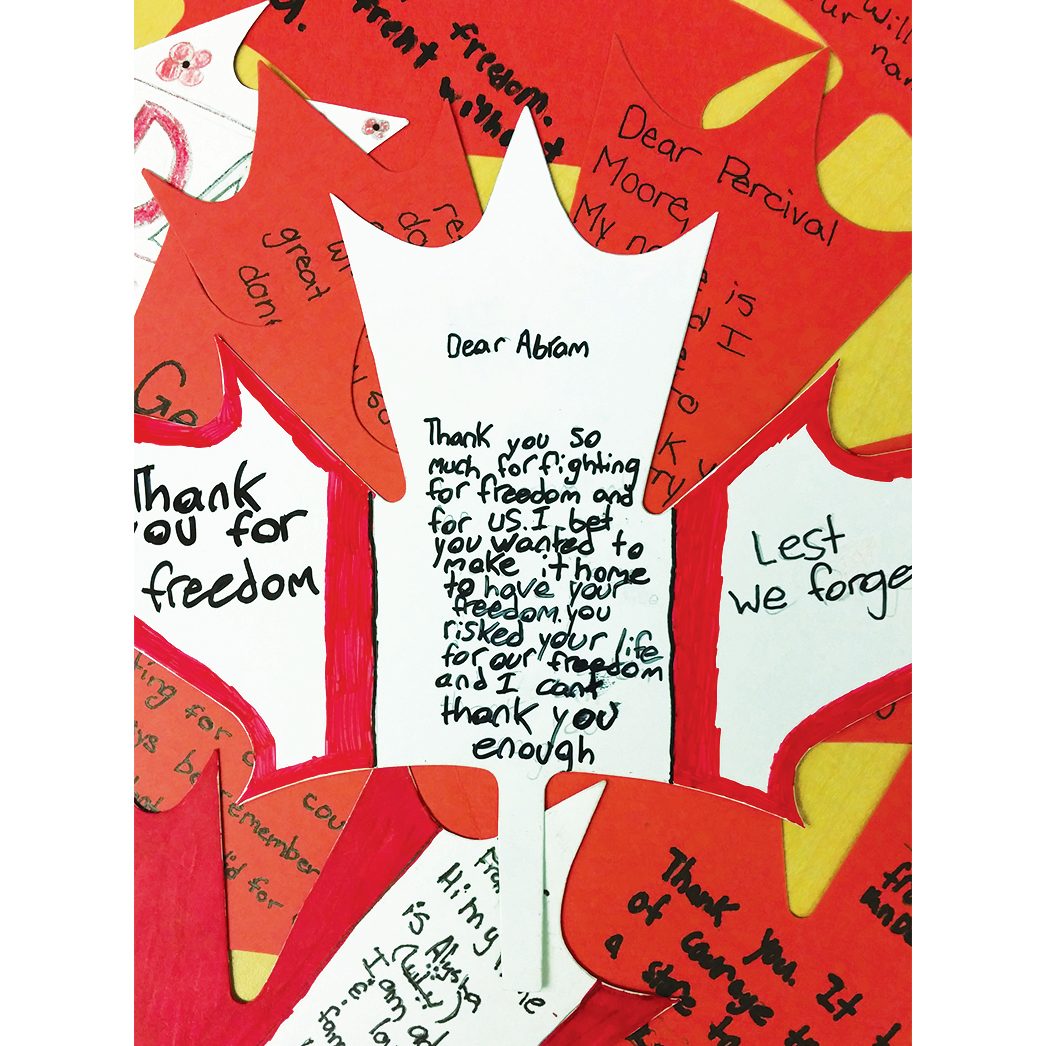
Part of the students’ task was to reflect on what learning about these men meant to them. Many expressed sadness and noted the young age of these men. Reece had this to say: “I thought doing this task was great because it connected me to someone that I never knew before. Even though I didn’t know him, I feel like I know him now.” Mack added, “I liked looking at the documents and seeing where he was from, what he did before the war, and seeing the dates of all the events.” As a teacher, these were truly rewarding reflections for me.
Once the students had gathered their information, they set about creating a tribute card in the shape of a maple leaf. On the front, they wrote a message to the fallen soldier; on the back, they signed their work and included a picture. I then had the cards laminated and packed them away in my suitcase for a long flight over the Atlantic Ocean later that summer. My brother and I had already planned a three-week trip that included a stop at Vimy Ridge. I made it my mission to deliver these messages from the younger generation to the graves of these fallen men.

Fast forward to July and I was soon on French soil, soaking up the war history and visiting many cemeteries from both world wars. At last, we arrived at Vimy. We visited the monument immediately and took time to reflect. My great-great-grandfather’s name is engraved on the wall there. Then, we made our way to Canadian Cemetery No. 2, Neuville St. Vaast, where many of the fallen from April 9, 1917, lay. Using a printed map of the cemetery, customized with the locations of the 18 graves I was to visit, I took my time placing the students’ work among the headstones. It was a roller coaster of emotion, from pride to sorrow. Before departing, I signed the cemetery guest book on behalf of my homeroom class—6M. Mission accomplished.

As a historian and teacher, I feel it’s important that current and future generations remain connected to the sacrifices of those who died for the very freedom we enjoy today. This trip allowed that goal to come full circle. I think Gavin summed it up best when he wrote to his soldier, “It would be amazing if I could meet you. I salute you for fighting for our freedom and giving your life to make ours better.” Lest we forget.
Don’t miss these incredible stories from Canadian veterans.
By now you’ve probably heard about the two most popular cannabinoids found in cannabis: THC, which gets you high, and CBD, which doesn’t but is known for its relaxing and anti-inflammatory properties. But have you heard about CBN? While it’s already popular in the U.S., CBN—available in everything from smokable flower to oils, gummies and vape pens—has only recently started to become more easily available in Canada. And I, for one, had been waiting for it.
That’s because CBN is loved by people who have trouble sleeping, a lousy club I’m a longtime member of. I’m always hoping that the latest “it” treatment will cure me for good, so I decided to put CBN to the test.
Taking CBN for Sleep
CBN is short for cannabinol. It’s an “oxidization product” of THC—when THC has been degraded by exposure to light, heat or oxygen, it turns into the less intoxicating, sleepy-making CBN. While there isn’t any peer-reviewed, scientific evidence that backs the use of CBN for sleep, that hasn’t stopped gushing anecdotal reports from flooding the Internet.
I bought three CBN products from the Ontario Cannabis Store: Field Trip GO: Slumber 5:1 CBN Shot; Renew CBN Oil by Solei and the perfunctorily named CBN 1:2 Night Formula Oil from Medipharm Labs.
I started on a Monday by downing the Field Trip shot a couple hours before bedtime. Thanks to a base of chamomile and lavender, it tastes flowery and sweet. I had quite a good sleep that night, which seemed promising, so the next night I moved on to the Renew oil, which comes with a five-millilitre dropper. Now for the hard part.
Cannabis laws in Canada prohibit brands from suggesting dosages, since technically it’s not supposed to be used as medicine. Other than a general “start-low-and-go-slow” adage, there’s zero official guidance on the packaging or on company websites because it’s not allowed—which would be hilarious if it weren’t utterly unhelpful. So I do the most scientific thing I can think of, which is shrug and take the whole dropper (a teaspoon). They wouldn’t have included it if I wasn’t supposed to take the whole thing, right?
Wrong. CBN doesn’t get you high, but I failed to notice that both of the oils I got also contain THC (the letters on the label are so small!). Did I sleep well that night, you might ask? Who remembers?!
Since that ill-fated rendezvous, I’ve been dosing myself very carefully with only one to two milligrams about an hour before bed, toggling back and forth between the two oils, which have similar effects. This has been much more successful. While I still have bad nights, I’m falling asleep more quickly, slumbering more deeply and having less trouble falling back asleep. And while my favourite formulation was the shot—which has one milligram of THC and five milligrams of CBN—it’s too expensive to take every night.
As CBN gets more popular, new formats will start hitting the shelves. I’m currently more excited to try the Ace Valley CBN Dream gummies than I was for the last season of Succession. Consider me sold.
Next, check out 10 podcasts to help you sleep better tonight.


